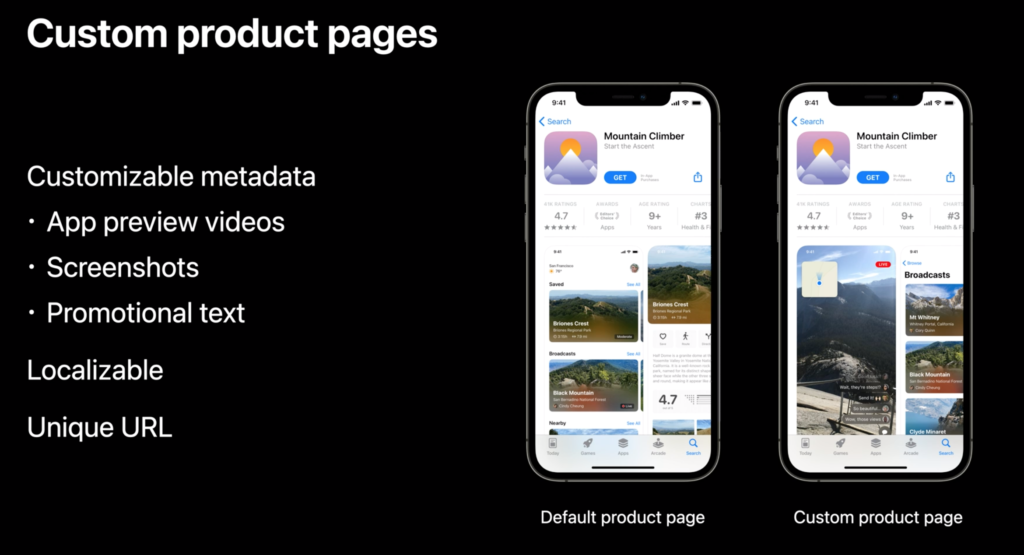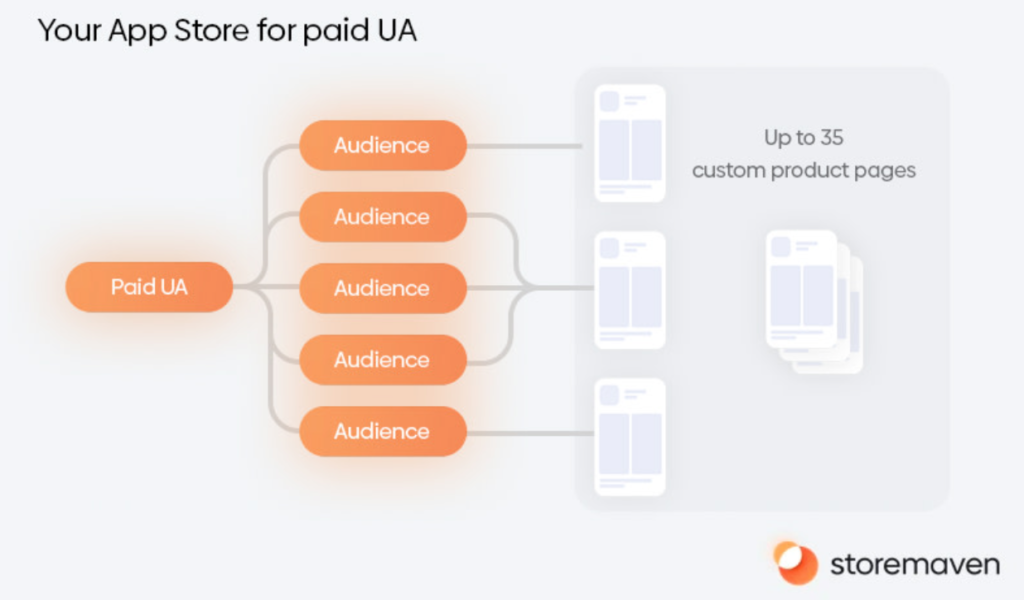Apple’s Product Page Customization – WWDC 2021
App Store Optimization (ASO)
October 12, 2022
On the third day of their 2021 edition of WWDC, Apple introduced 2 new tools for your app’s product pages: product page customization and product page optimization. In this article, we’ll focus on product page customization, what is it and how can you make the best of it? Starting in the Fall with the launch of iOS 15, developers will be able to customize their product page and create up to 35 different customization options!
What’s Product Page Customization?
As of today, there is only one product page for your app on the App Store. Unlike on the Google Play Store where you can create 5 customized pages, all your customers land on the same page and are faced with the same content. This won’t necessarily be the case after the release of iOS 15. Not only will you be able to create 35 custom product pages, but each of them will let you showcase different features and content for different users.
You’ll be able to have a different set of app preview videos, screenshots, and promotional text on each page, they will also be fully localizable on their own and shareable using their unique URL. App Analytics will also grant you data specific to each page such as impressions, downloads, conversion rate, retention data, and average proceeds per paying user. You won’t be able to change your app logo, title, and subtitle, and before being published, each page will still need to be approved by Apple Review.

However, according to the information available so far, these custom pages will only be reachable through their unique URL and not organic search within the App Store. This means that these custom pages will most likely be used as a landing page for your digital marketing campaigns.
To recap, these are the main characteristics of custom product pages as advertised by Apple so far:
- You can create 35 different custom product pages
- You can customize app preview videos, screenshots, and promotional text
- You can’t modify the icon, title, and subtitle on your custom pages
- Each page will have its own shareable URL (which will be the only way to access it according to current information shared by Apple)
- Each page is fully localizable
- Metrics specific to each page will be accessible through App Analytics
- Each page will need to go through App Review before being published but you won’t need to re-submit a new version of your app
How can you make the best of this new option?
Because these custom product pages will only be accessible through URL, you can use them to drive traffic to your product while adapting your messaging to your traffic source. Let’s say you launch ads on TikTok and Instagram to promote your app. On both of these platforms, you will have a different audience, and now you will be able to send these audiences to a landing page that matches the ad they just saw. And because your ad will be tailored to a specific audience, your landing page will match these users’ expectations.
Thanks to this feature, you’ll be able to tailor your messaging to different audiences according to where you’re encountering them (social media, in-app ads, your website, even influencers’ campaigns), allowing you to highlight specific features of your app/game for a more targeted audience.

iOS 15 will allow your landing pages to match the ad that drew customers there, they will find, on the other side of the link shared in the ad, a landing page that uses the same visuals than the ad they followed. Adapting, not only your ad but your landing page to your user’s expectation can be a great boost for your conversion rates and ROAS.
Moreover, you can tailor your custom pages to showcase specific functions, putting one character of your game in the spotlight for example. You need to settle on specific goals you want to reach, divide your audience into key groups, and decide what you want to show to each group to get them interested in your app.
Now what? Which challenges await custom product pages?
According to what Apple shared, you won’t be able to run the new A/B testing feature on custom store pages, you’ll have to rely on the data provided to you by App Analytics after they’ve been published. There was noticeably no mention on whether or not these pages could be used for discovery within the App Store, by using a certain keyword for example. The main consensus seems to be that these custom pages will only be reachable through their custom URLs, and as such, mainly used as landing pages for paid user acquisition.
Also, someone pointed out that Facebook and Google App Campaigns send people straight to the App Store, so we’ll have to wait and see if they allow developers to link to a specific custom page link.
Will it also push Google Play to switch up its own customization? While Apple announced 35 custom product pages, Google still has a maximum of 5 custom store listings. And where Google’s custom store listing only allows you to target users based on location or installation status, its custom listings are still accessible organically, unlike Apple’s announcements which can only be displayed to customers coming from outside the App Store.
The iOS 15 launch in the Fall will probably bring us more information on Apple’s product page customization. In the meantime, what are your thoughts on it? Will you try it out?
- Mobile Video Monthly #38 – November 2023 - 5 December 2023
- Disturbing ads, a new trend for mobile gaming creatives? - 28 November 2023
- The Power of Holiday Marketing in Boosting Mobile Game Engagement - 21 November 2023

